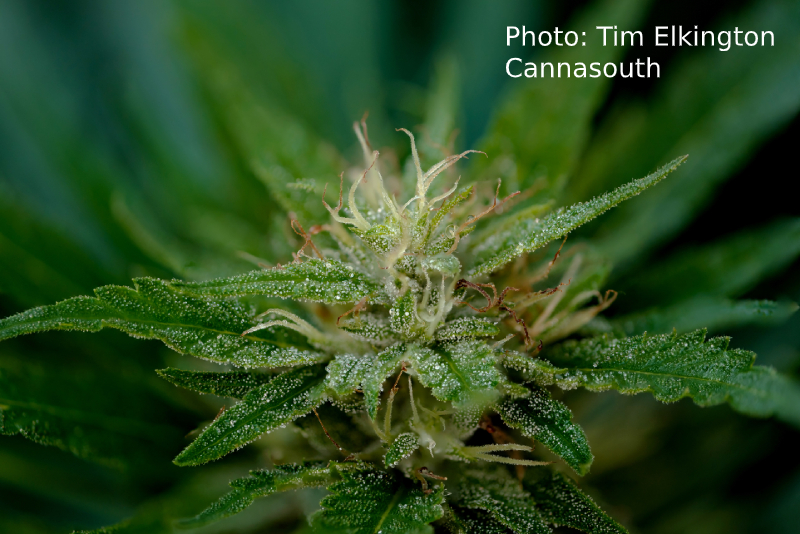Take a closer look at your cannabis buds…
https://joom.ag/u8Pe – iHemp #8 Oct 2019

They’re covered in a sticky dusting of crystal resin, which contains hundreds of therapeutic compounds known as cannabinoids, terpenes and flavonoids (CTF).
We assume you’re well acquainted with THC and CBD, but these are just two among many important players working together to produce specific effects.
This interactive synergy between cannabis compounds has been coined the “Entourage Effect,” and once you know what this is, you’ll see why medicines containing only THC or CBD aren’t always sufficient for many medical conditions…
What are ‘THC and CBD Only’ medicines?
THC-only medicines primarily refer to synthetic renderings of THC, the two most popular being Marinol (dronabinol) and Cesamet (nabilone). These are legal pharmaceuticals primarily prescribed to treat cancer-related nausea, but their efficacy is questionable. A 2011 survey on forms of consumption found only 1.8% of 953 patients prefer synthetic THC pharmaceuticals over inhaled or infused methods. Furthermore, it can take hours for a THC-only pill to deliver relief whereas inhaled methods take effect immediately.
CBD-only medicines have been gaining momentum in recent years following the media frenzy around Charlotte’s Web, a nonintoxicating cannabis strain that was processed into a CBD-rich oil for an epileptic child. The miraculous remedy prompted several states to adopt CBD-only laws under which THC-rich medicines remain illegal. While CBD-only cannabis medicines have proven to be life-changing for many individuals, these laws mainly exist to help those suffering from seizures.
That is not to say that synthetic, hemp-based, and CBD-only medicines aren’t effective options for many patients, especially as laws limit access to alternatives. These types of products have served a monumental role both as medicine and as a legislative stepping stone. But what more can patients get from whole plant medicine?
What makes “Whole Plant Medicine” different?
“Whole plant medicine” is a term used to describe medicines utilizing the full spectrum of therapeutic compounds cannabis has to offer. A glimpse of the most abundant cannabinoids, terpenes and flavonoids is provided next page in our two graphics illustrating the properties and benefits of each…

As you can see, each of these therapeutic agents that are processed out of THC and CBD only medicines have so much to offer patients treating a wide range of symptoms and conditions.
You’re already familiar with the most popular “whole plant medicine,” which is inhaling cannabis smoke or vapor. Although most cannabis today is bred to contain a disproportionately large amount of THC compared to other compounds, the importance of chemical diversity is being realized as new strains emerge.
Hopefully, we’ll soon start to see strains that not only narrow the gap between THC and CBD profiles, but emphasize other important cannabinoids and terpenes as well.
Cannabinoids and Terpenes Work Together
The diverse chemical availability in whole plant medicines is remarkable in its own right, but research looking into how cannabinoids and terpenoids work together adds another level of intrigue.

Instrumental in this area of science is Ethan Russo, M.D., a neurologist who has long studied cannabis compounds and their role in the body. In his study “Taming THC: potential cannabis synergy and phytocannabinoid-terpenoid entourage effects,” he details how cannabis compounds influence each other’s mechanisms. We aren’t just talking about the well-known THCCBD tag team here – even small amounts of terpenes (fragrant oils that give cannabis its smell) can make a difference.

The full interaction of all cannabinoid & terpene compounds within the body’s endocannabinoid system after delivery is known as the “entourage effect”.
The individual terpene profile in each strain influences the experience due to the synergy or intercommunication of the compounds in that flower.
Like cannabinoids, terpenes bind to receptors in the brain and give rise to various effects. Terpenes are fragile so to prevent degradation, always store sealed in a cool and dark place.
Examples of Terpene use:
- Myrcene, can reduce resistance in the blood-brain barrier, enabling easier passage of other beneficial chemicals.
- Pinene helps counteract compromised cognition and memory caused by THC.
- A combination of terpenes pinene, myrcene, and caryophyllene help unravel anxiety.
- Mixing terpenes linalool and limonene with the cannabinoid CBG shows promise in the treatment of MRSA.
- THC plus CBN yields enhanced sedating effects.
- Linalool and limonene combined with CBD is being examined as an anti-acne treatment.
These examples only scratch the surface of all possible synergies made available to us by way of whole plant therapies.
The full interaction of all cannabinoid & terpene compounds within the body’s endocannabinoid system after delivery is known as the “entourage effect”.
The individual terpene profile in each strain influences the experience due to the synergy or intercommunication of the compounds in that flower.
Like cannabinoids, terpenes bind to receptors in the brain and give rise to various effects. Terpenes are fragile so to prevent degradation, always store sealed in a cool and dark place.
Think of all the medical possibilities waiting for us as the combinational potential of these compounds are unlocked. The thought of how many lives could be changed for the better by such discoveries is almost overwhelming.
